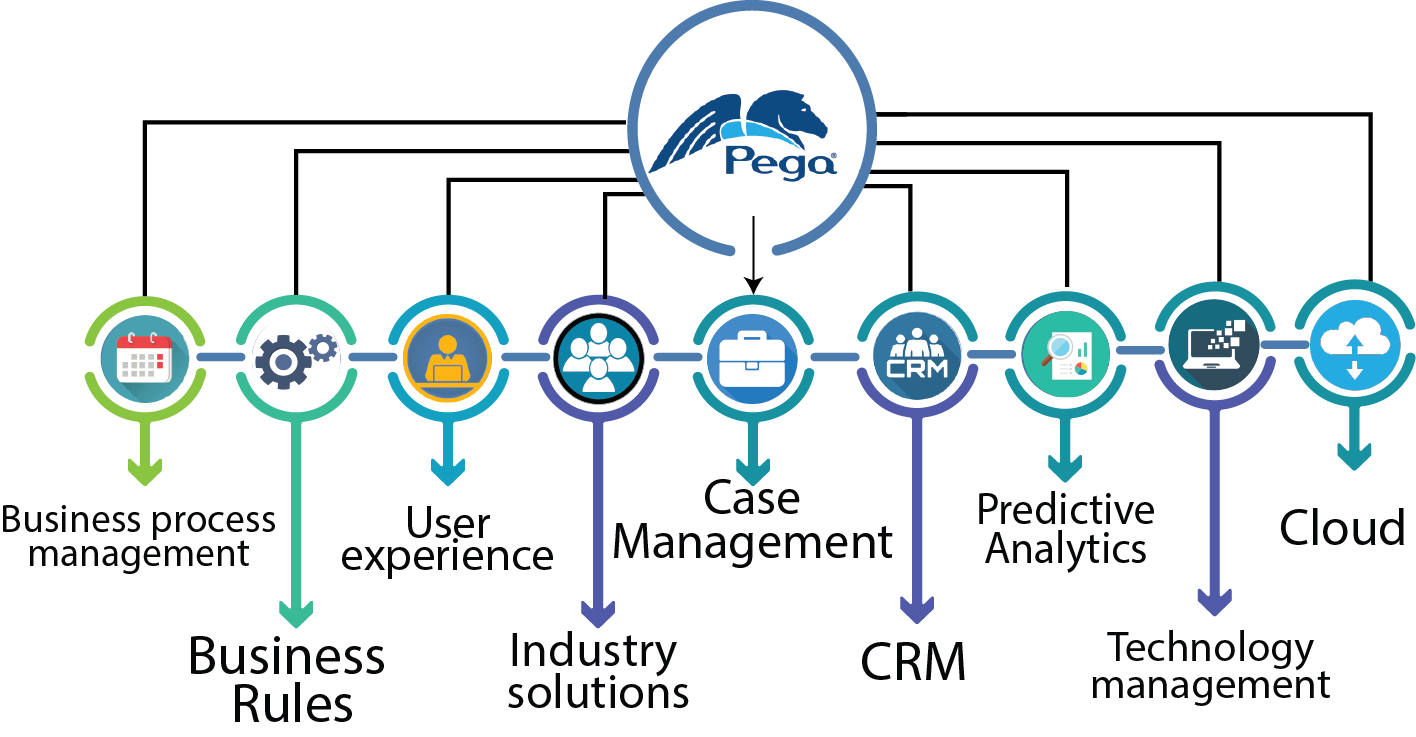What is pega?
Pega is a highly regarded Business Process Management (BPM) tool founded on Java concepts. This platform provides structured methods for deploying and developing rule-based processes, enabling rapid changes compared to traditional Java-based apps. Pega's transformative capabilities contribute to cost reduction and enhanced business performance, making it a premium tool for enterprises seeking process automation and efficiency improvements. Pega's BPM technology offers tailor-made business apps, delivering results and end-user experiences aligned with specific needs. With its built-in Designer Studio IDE tool, Pega streamlines app development, harnessing the power of Java and OOPs principles.
Interested in learning Pega? Join HKR and Learn more about Pega Tool from the Pega Training
Why Pega?
Pega stands out as a software tool that combines BPM and CRM features. It goes beyond conventional tools, providing an integrated platform to catalyze business improvement. Pega's intuitive Visual Designer Studio empowers designers to create expertise without the need for extensive coding skills. Its portability allows the management of private and cloud-based environments, facilitating the construction of essential application components.
Pega is engineered to eliminate coding issues, automating the development of intricate systems while primarily reducing development time. Pega products are Java-based, delivering code management at runtime. The versatility of Pega's BPM solution lies in its ability to be deployed anywhere, offering time and resource savings. Its adaptability and accessibility are rooted in its low-code approach, ensuring quick adaptation to evolving requirements and processes.
Pega Architecture
Pegasystems' BPM architecture centralizes process objects, rules, user interfaces, and specifications, separating it from other BPM tools like IBM Lombardi or Oracle BPM. Unlike these tools, Pega avoids the fragmentation of tools for reporting, process design, integration, requirement selection, and screen design.

The core competent components of the pega architecture are:
1) Case Management Services:
These support collaborations, data management, integrations, human and machine work management, automation of documentation, and low-code app development.
2) BPM Services:
Encompassing process simulation, modelling, routing logic management, SLA handling, workflow execution, and policy enforcement.
3) Business Rule Services:
Focused on process integration, execution monitoring, and management.

Pega Certification Training
- Master Your Craft
- Lifetime LMS & Faculty Access
- 24/7 online expert support
- Real-world & Project Based Learning
BPM Methodology
Pega follows a structured BPM methodology consisting of five essential steps:
1) Analysis:
Involves comprehensive exploration and definition of mechanisms to meet business needs and enhance efficiency, setting the stage for designing solutions.
2) Design:
It Develops workflows involving human-to-human, system-to-system, or human-to-system interactions, emphasizing error reduction and adherence to standard operating procedures.
3) Business Rules Engine
It implements a model-driven approach to control process execution.
4) Execution
Requires monitoring processes to collect performance, error, and compliance data, using testing to assess BPM solutions against design templates and KPIs.
5) Monitoring and Optimization
Focuses on modelling and data tracking to identify areas for improvement, ultimately enhancing productivity and value.
Pega PRPC
Pega PRPC, or Pega Rules Process Commander, serves as the central component of PegaSystems. PRPC is a model-driven platform that eliminates the need for coding in languages like Java, HTML, SQL, and CSS.
PRPC comprises two units:
- Process Commander: A pre-installed rule set that facilitates development and customization.
- Pega Rules: A Java-based Rules Engine.
PRPC streamlines and automates business processes, integrating diverse functions into a single cohesive system. Its uses range from automating, recording, and streamlining business processes to managing data effectively.
What are the uses of PRPC ?
PRPC offers several advantages:
- Cost-effective, efficient, and rapid development.
- Customer-centric approach.
- Reduces business risks, duplication, and errors.
- Enhances productivity while reducing IT costs.
- Provides enhanced security.
- It adapts easily to evolving business needs.
Efficiency of BPM workflow tools
BPM tools offer comprehensive capabilities, including workflow management, form generation, business rule engines, analytics, and integrations. These tools enable businesses to leverage data, generate metrics, and define standard and custom reports. They simplify complex workflows, support the creation of intricate business rules, facilitate web-form development, and promote collaboration.
frequently asked Pega Interview Questions and Answers !!
Benefits of BPM
Pega BPM software enhances business process efficiencies by:
- Offering cost-effective, efficient, and rapid development.
- Prioritizing customer-centric solutions.
- Reducing business risks, duplication, and errors.
- Enhancing productivity while lowering IT costs.
- Ensuring improved security.
- Adapting seamlessly to evolving business needs.
Basic Differences between the BPM and Code level management
While BPM shares similarities with code-level management, it offers unique capabilities:
- BPM focuses on operational efficiencies, while low-code platforms expedite operations.
- BPM connects processes and functions across organizations, making it accessible to non-developers with minimal coding knowledge.
Visit here to learn Pega Training in Bangalore

Subscribe to our YouTube channel to get new updates..!
Features of the Pega BPM
Pega BPM boasts several key features that empower organizations to streamline their business processes effectively:
- Quick Integration with IT Infrastructure: Pega BPM seamlessly integrates with your existing IT infrastructure, facilitating a swift and efficient transition.
- Service-Oriented Architecture: Pega follows a service-oriented architecture (SOA) approach, ensuring flexibility and scalability in your business processes.
- Rules-Driven Process Alignment: Pega BPM emphasizes rules-driven alignment of business processes, allowing for consistency and adherence to predefined rules and guidelines.
- Intuitive Mapping and Simulation: The platform provides an intuitive mapping and simulation of business processes, enabling users to visualize and optimize workflows easily.
- Interactive Real-Time View: Pega BPM offers an interactive, real-time view of activities across your entire enterprise, enhancing transparency and decision-making.
Phases of the Pega BPM software:
Pega BPM is structured into five distinct phases, each contributing to the efficient execution of business processes:
Model Phase:
In the Model phase, Pega BPM aids in identifying, describing, and representing the complete mechanism of your processes. This phase promotes easy comprehension and effective communication of process details.
Execute Phase:
The Execute phase focuses on developing and enforcing the procedures necessary for repetitive process execution. Automation is extended to its maximum potential during this phase, streamlining operations.
Control Phase:
The Control phase plays a vital role in maintaining a smooth flow of processes. It ensures that methods are well-monitored and managed, reducing disruptions and bottlenecks.
Monitor Phase:
During the Monitor phase, meaningful and observable data is collected to ensure process consistency and the achievement of desired value and benefits. This phase emphasizes performance and compliance monitoring.
Optimize Phase:
The Optimize phase leverages the data collected to refine and enhance the modelling process. It assesses the gathered insights to identify further improvements in the process, promoting continuous optimization.
These phases collectively form a structured approach to business process management, allowing companies to efficiently model, execute, control, monitor, and optimize their processes for sustained success.
Advantages and disadvantages of pega BPM
The advantages of the pega BPM are:
- Unified system architecture.
- Integration of predictive analytics and business rule management.
- Innovative solutions at competitive prices.
- Interactive desktop exploration and robotic process automation capabilities.
- Versatile data structures like "Data Pages."
Disadvantages of Pega BPM include:
- Learning curve, particularly with Pega 7.
- Challenges in finding resources with Pega 7 expertise.
- Limited promotion of Pega 7 and Pega Express as standalone iBPMS channels.
- Cost concerns for larger enterprises relative to value.
Explore pega Sample Resumes! Download & Edit, Get Noticed by Top Employers!
Future and Scope of Pega BPM:
Pega's future in BPM and CRM applications remains promising, with numerous large and local companies adopting it for service and product development. Developments in Pega include AI integration and application digitalization, making it an essential player in emerging technologies. Pega empowers development teams to create versatile applications, including web services, CRM solutions, and user interfaces. Its reusability and reliability position it as a valuable asset for constant innovation and fostering loyal multi-channel customer relationships. Pega developers are in high demand, reflecting the bright prospects of Pega BPM.
Applications of BPM Software
BPM software finds applications in diverse areas such as compliance, complaint management, loan origination, project management, invoice processing, account management, employee onboarding, and expense reporting.
Choosing the Right BPM Tool
Selecting the right BPM tool involves considering factors like cost, hosting options, usability, responsiveness, and integrations. Costs may vary based on factors such as user base size, customization options, on-site vs. cloud software, and more. Usability plays a crucial role in user adoption and technical proficiency. Automation depends on proper integration, while responsive web design ensures an intuitive user experience. Hosting options should align with the organization's resources and scalability needs.

Conclusion
PEGA became a great tool in the software ecosystem. The features and benefits of PEGA acquired more customer base as they are a user friendly and integrated system. The RPA version has paved the way in emerging technologies by process of automation. Its AI or Software Robots have fit in today’s industrial advancements. PEGA’s various features attracted users to look into it. In this article, we have provided the necessary information regarding PEGA. If you need further details regarding training and online sessions, contact us.
Related Articles:
About Author
Kavya works for HKR Trainings institute as a technical writer with diverse experience in many kinds of technology-related content development. She holds a graduate education in the Computer science and Engineering stream. She has cultivated strong technical skills from reading tech blogs and also doing a lot of research related to content. She manages to write great content in many fields like Programming & Frameworks, Enterprise Integration, Web Development, SAP, and Business Process Management (BPM). Connect her on LinkedIn and Twitter.
Upcoming Pega Certification Training Online classes
| Batch starts on 4th Jan 2026 |
|
||
| Batch starts on 8th Jan 2026 |
|
||
| Batch starts on 12th Jan 2026 |
|

